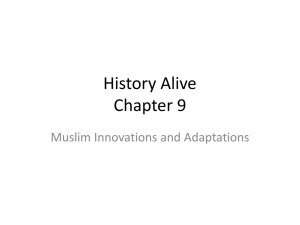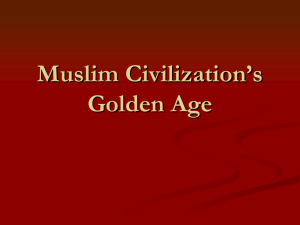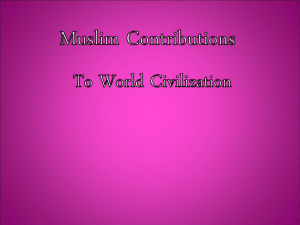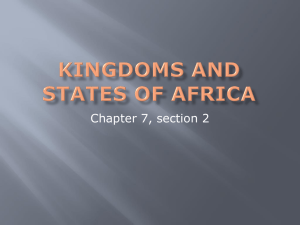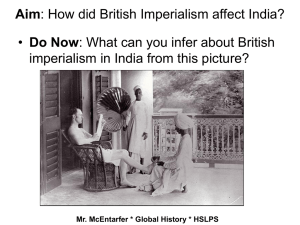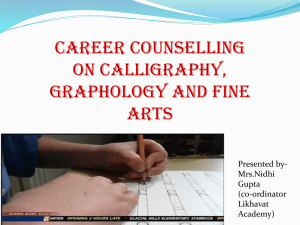contributions of muslims to world civilization
advertisement
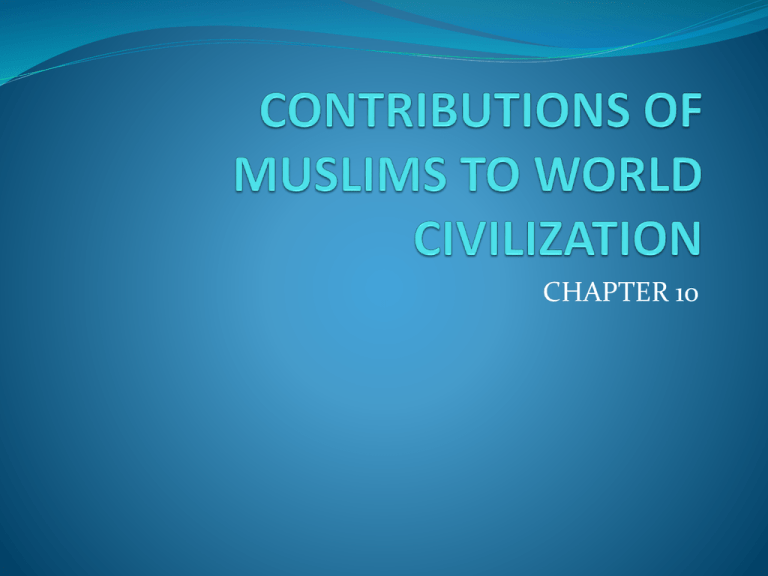
CHAPTER 10 Muslim Contributions During much of the medieval period, Muslim civilization was in some ways more advanced than others Made major advancements in: astronomy, zoology, geography, arithmetic, navigation, art, architecture, and technology Muslim Contributions Had Muslim Scholars not translated classic Greek texts, the European Renaissance would not have happened in the way that it did In spite of this, Muslims have not always been recognized for their contributions to world civilizations ACTIVITY DIRECTIONS With your partner(s), examine one of the 16 placard on the walls. Turn to Reading Notes 10 (p 62) and decide which of the 16 topics the placard relates to. Pencil in the letter of the placard next to that topic. Scan sections 10.3-10.11 to find the passage that matches the contribution. Check your answer with the sticky note (DO NOT CHEAT) and then read the passage if you are correct. On the map, draw a symbol for the contribution in the appropriate location. If a contribution isn’t related to a specific location on the map, draw your symbol in an open space. On the page opposite the map, write a summary of the contribution Reviewing Muslim Contributions Each group has several placards You are going to present your placard to the class by describing the Muslim Contribution You will have a few minutes to prepare your sections and then you will present them to the class. Talk to the class, do not read to the class. Be prepared to note the significant contributions and the symbol you put on the map and where you put the symbol. Make sure your presentation is professional and prepared. Flowering of Islamic Civilization – 10.2 (no card) Arab conquests had created a vast Muslim empire – Spain, N. Africa and much of western and central Asia came under Muslim rule. Islamic civilization flourished – great cities where scholars and artists made many advances Baghdad – important city Cairo – important city Jews, Christians and Muslims worked and studied togther 10.3 City Building and Architecture #2 Baghdad – Card I #11 Mosques – Card K Baghdad: Abbasid capital – more central for the entire empire Village between Tigris and Euphrates Rivers – cross road of trade routes connecting the empire At center of the city is where the caliph’s palace and grand mosque is – city is round Double wall with guards, guarded inner part of city One of world’s largest cities 10.3 City Building and Architecture #2 Baghdad – Card I #11 Mosques – Card K Mosques: Muslim house of worship Had a minaret (tower) with a small balcony where the call to prayer comes from. Fountain for washing Prayer room inside – worshipers sit on mats and carpets Imam – prayer leader. 10.4 Scholarship and Learning #14 Scholarship and Learning – Card J “The ink of scholars is more precious than the blood of martyrs.” 8th century, Arabic was the language of scholarship and science Shared language and love of learning allowed ideas to exchange and build upon others work Built schools and libraries in Muslim cities People came from all over world to work together 10.4 Scholarship and Learning #14 Scholarship and Learning – Card J Hall of Wisdom – Cairo – could visit to read books and study Cordoba, Spain library had 400,000 volumes of books Muslim people studied Plato and Aristotle and used reasoning and logic 10.4 Scholarship and Learning #14 Scholarship and Learning – Card J Sometimes wondered how to make reason and logical proof agree with their religious faith. Humans had 2 sources of knowledge: reason and revelation by God Ibn Sina, become Islam’s most famous philosopher – believed all knowledge came from God and that truth could be known through revelation and reason 10.5 Science and Technology #1 Astronomy – Card F #16 Zoology Card H #7 Irrigation and Underground Wells – Card M Astronomy – compasses and astrolabes helped locate Makkah. Allowed worshipers far from Holy city pray facing right direction. Also able to find out the exact times for prayer and month of Ramadan using astronomy Also just wanted to learn about the universe. Also thought Earth was center of universe with the sun and stars going around Earth – is this true? 10.5 Science and Technology #1 Astronomy – Card F #16 Zoology Card H #7 Irrigation and Underground Wells – Card M Zoology – scientific study of animals Wrote books describing animal bone structure How to make medicine for animals Evolution of animals Established zoos 10.6 Geography and Navigation # 5 Geography and Navigation – Card P Examined plants and animals in different regions Divided world into climate zones Calculated Earth’s circumference accurately Irrigation and Underground Wells Created accurate maps Travelers could get information for water resources to help in travel and trade Wrote guidebooks for travelers Used compasses – probably learned from Chinese 10.6 Geography and Navigation # 5 Geography and Navigation – Card P Examined plants and animals in different regions Divided world into climate zones Calculated Earth’s circumference accurately Irrigation and Underground Wells Created accurate maps Travelers couldget information for water resources to help in travel and trade Wrote guidebooks for travelers Used compasses – probably learned from Chinese 10.7 Mathematics #9 Mathematics – Card O Based work on India and classical Greece Learned from Euclid Khwarizmi – worked at House of Wisdom – father of algebra Helped populate Arabic numbers in Europe Populated the use of the number Zero Zero makes it easier to write large numbers 10.8 Medicine #10 Medicine – Card L Some of most contributions in this field Learned from Greeks, Mesopotamians, Egyptians Established 1st hospitals – Baghdad had 5 Doctors treated disease with diet, drugs and exercise Did surgery – hospitals were advanced al-Razi, realized bacteria spread infection – studied smallpox and measles 10.9 Bookmaking and Literature #8 Bookmaking and Literature – Card N Paper making helped literature grow Bookmaking was an artform Bookmaking was a big business Arabs had rich story telling tradition – now they could share it in writing Arabian Nights – famous Arabic book Sufism or Islamic mysticism – helped enhance this through poetry 10.10 Art and Music #3 Calligraphy – Card D #12 Music – Card G #6 Geometric/floral design – B #15 Textiles - E Geometric and Floral Design- famous for decorative art Illustrated Manuscripts Applied talent to everyday items – plates, glassware, clothes, walls of mosques Arabesque – natural world – leaves, flowers, etc. Made metal boxes, ceramic bowls, tiles, carpets Used geometric shapes in designs 10.10 Art and Music #3 Calligraphy – Card D #12 Music – Card G #6 Geometric/floral design – B #15 Textiles - E Calligraphy – highest form of decorative art Qur’an – felt only calligraphy would do for writing Used Calligraphy to decorate everyday items 10.10 Art and Music #3 Calligraphy – Card D #12 Music – Card G #6 Geometric/floral design – B #15 Textiles - E Textiles: cloths or textiles, rugs, etc. Great effort in making these artistic Sometimes had inscriptions or designs showing important events Sometimes embroidered Clothes showed rank and served as a status in Muslim world 10.10 Art and Music #3 Calligraphy – Card D #12 Music – Card G #6 Geometric/floral design – B #15 Textiles - E Music: Baghdad, Damascus – centers of Muslim Music world Ziryab, talented musician and singer from Baghdad – established first music school Singing was essential part of Muslim Spain’s musical culture Created songs about love, nature and glory of the empire 10.11 Recreation #13 Polo – Card C #4 Chess – Card A Polo – learned about it from the Persians Played on horses – Muslims saw horses as a status symbol Chess: invented in India. Persians introduced it to Muslims Caliphs invited chess champions including women and slaves to their palaces to play in matches - intellectual challenge Friday, November 11, 2011 On a separate sheet of paper answer the following question WITH DETAIL – to be turned in when finished! In your opinion, what was the most important Muslim achievement? Why? Give detail. Human Spectrum With your partner(s) go through the list of contributions and rank them. You are going to do this 2 ways 1. in order of importance (1 -16) 1 meaning the most important, 16 being the least important 2. go through each contribution and rank it on a scale of 1-4; 1 being really important, 4 being least important Example: Mathematics – Rank #8; and 1 on a scale of 1-4
